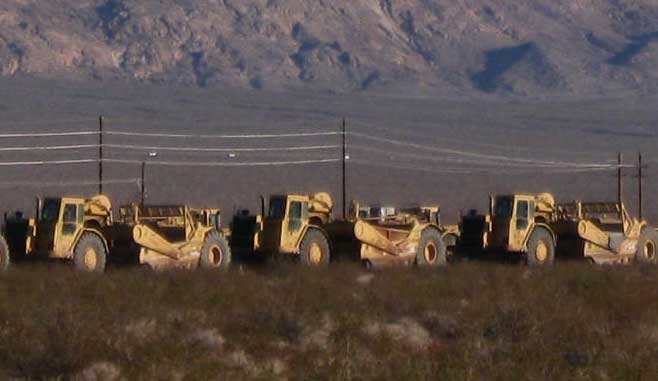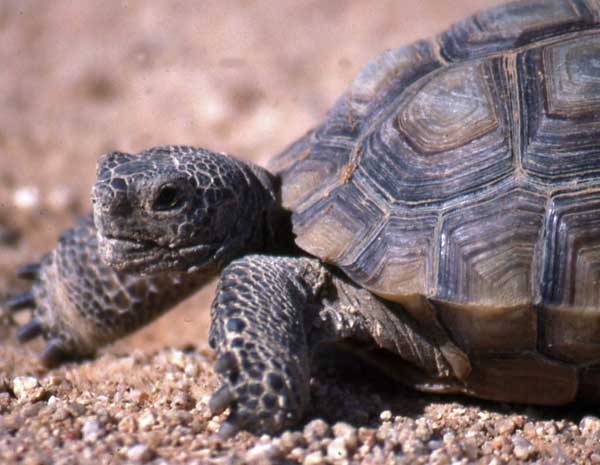BLM Public Meeting
May 12, 2010 - Henderson, Nevada
 We attended the Nextlight Silver State public meeting in Henderson near Las Vegas. Nextlight Silver State will be up to a 4,818 acre solar photovoltaic facility on very good tortoise habitat close to Primm, Nevada.
We attended the Nextlight Silver State public meeting in Henderson near Las Vegas. Nextlight Silver State will be up to a 4,818 acre solar photovoltaic facility on very good tortoise habitat close to Primm, Nevada.
Bureau of Land Management (BLM) is having a very difficult time identifying a translocation site. The plan for the site has been changed from moving the tortoises to a depletion zone north of Searchlight, Nevada, to an area close to the Walking Box Ranch west of Searchlight, Nevada which appears to be a higher elevation than the Nextlight site (up to 800 feet higher). The translocation site they are looking at now is in Critical Habitat located in the same recovery unit. They do not know if this will work and are employing the same biologists to study the site as a feasible translocation site. They still plan to excavate 150 to 250 desert tortoise and attempt to move them.
First Solar, owner of NextLight, claims that their site design will be more "ecological" because they will leave some plants growing under the panels. They also claim they will also leave wash corridors for "connectivity," but such long narrow pathways between industrial disturbance do not qualify biologically as useful (see discussion for the Ridgecrest Solar Power Project concerning tortoise and Mojave ground squirrel connectivity conservation >>here).
The plan is to re-route the ORV route around the north east side of the project. As it stands now, most of the ORV routes have been separated from the excellent tortoise habitat by railroad tracks. BLM's plan to mitigate ORV routes by routing them directly into the habitat would no doubt invite trespass and become a corridor for invasive plants. As it stands now, the site is more weed-free than most parts of the Ivanpah Valley. So the plan appears to be, turn part of this bajada into an industrial energy zone, removing close to 4,000 acres of habitat for photovoltaic panels and re-route ORV recreation trails into the heart of the remaining good habitat and some how manage the area as a tortoise habitat. ORV groups are now supporting the project. The dust from the off-road vehicles will probably create a need for more panel washing water.
The Silver State project is Fast-tracked, and BLM estimates that they will issue a Record of Decision in September 2010. Estimates of construction costs to build this project are from $1.6 billion to $2 billion.
The Draft Environmental Impact Statement (DEIS) is not a good environmental impact analysis because it admits that no rare plant surveys have been conducted yet, no surveys for Gila monster, Burrowing owl, Golden eagles, Bighorn sheep, or other wildlife have been conducted yet and lacks information about the genetics of the Northeast Recovery Unit for the tortoise. The deadline for comments on the DEIS is June 1, 2010.

<Middle of the project site on the fan west of the Lucy Gray Mountains, with Mojave yucca, creosote, bursage, Calico cactus, and Silver cholla.
Fixed Tilt Thin Film Technology

First Solar has specialized technology, and uses fixed tilt Cadmium Telluride thin-film photovoltaic panels. The Draft Environmental Impact Statement has three different photovoltaic technology options, stating that the applicant still has not determined which will be chosen for the final project. Yet after First Solar bought NextLight, only the fixed tilt technology would be the option. This was not reflected at the scoping meeting, where the public was still presented with the possibility that three different technologies would be analyzed for the Final Environmental Impact Statement.
Also confusing is whether vegetation will be left inside the solar field, or whether the area will be graded. The DEIS indicates considerable "grading and grubbing" will have to be done, but at the meeting BLM told us that the applicant intends to leave desert plants growing in between the panels, and that grading would only be done at the cement foundations that would hold the panels. If Fixed tilt panels are indeed chosen, then they would probably be held by poles which would be driven into the ground.
First Solar seems to have a standard policy of telling agencies and the public that desert animals would be allowed to roam and live among the solar panels, but this would be a bad idea in many ways: burrowing animals such as tortoises and kit foxes could get under panel foundations and undermine them, disrupting exact angles needed for intercepting solar rays and reducing efficiency; and tortoise and other animals would be under increased threat of being run over by trucks during operation and maintenance on the many roads through the project.
BLM said First Solar would clip the shrubs initially, but was not clear whether vegetation would be mowed after that. Creosote will stump-sprout, especially after rainy years, and can grow to six or seven feet. Will these create a problem of shading the solar panels? The other option is to completely scrape the vegetation away and apply herbicides to keep growth down, also not the best way to manage a desert ecosystem.

<Sign at public meeting, May 2010, showing three choices of photovoltaic types. Other options included Tilted tracker solar panels and Horizontal tracker solar panels.

<Graphic at the public meeting of proposed Fixed tilt solar panel field makes it appear as if desert shrubs will be left growing in between the panels.

^Copper Mountain solar panels, Boulder City green zone, Nevada.

^Copper Mountain expansion, areas of desert being graded.

^Scraper-graders lined up at the Copper Mountain thin-film solar project at Boulder City, Nevada.

<Project site on the fan, with Primm in the distance.


^Flowering baileya (Baileya radiata), May 2010.
>Project site on the lush fan, looking up towards the Lucy Gray Mountains.

^Desert tortoise (Gopherus agassizii).

<View looking north from Ivanpah Road in Mojave National Preserve. The project would be visible on the sloping fan in the distance. Ivanpah Playa lies to the left.

<Ivanpah Playa full of water after rains in winter 2010. This water largely collected in the basin after pouring off the surrounding mountain ranges and running down fan washes, many of which go through the proposed project site. View looking eastward towards the Lucy Gray Mountains.

<Wash with minor flash flood, summer 2009, on the project site.

>The applicant's "flow-through" design, where these high-energy washes coming down the fan would be allowed to go through the solar panel project site. Berms would be built up along the edges of some of these washes, but erosion of berms is a serious question over time.

^Computer image of how the solar panels would appear on the fan.
Flyer handed out at the scoping meeting:


<Sunset in Ivanpah Valley over the playa, looking eastwards toward the fan where the project is proposed, and the Lucy Gray and McCullough Ranges. Winter 2010.
HOME.....Updates.....2009 Field Visit.....August 2009 Scoping Meeting
